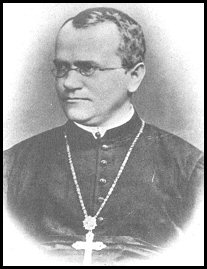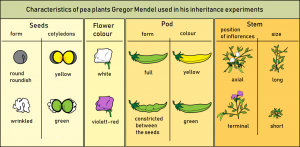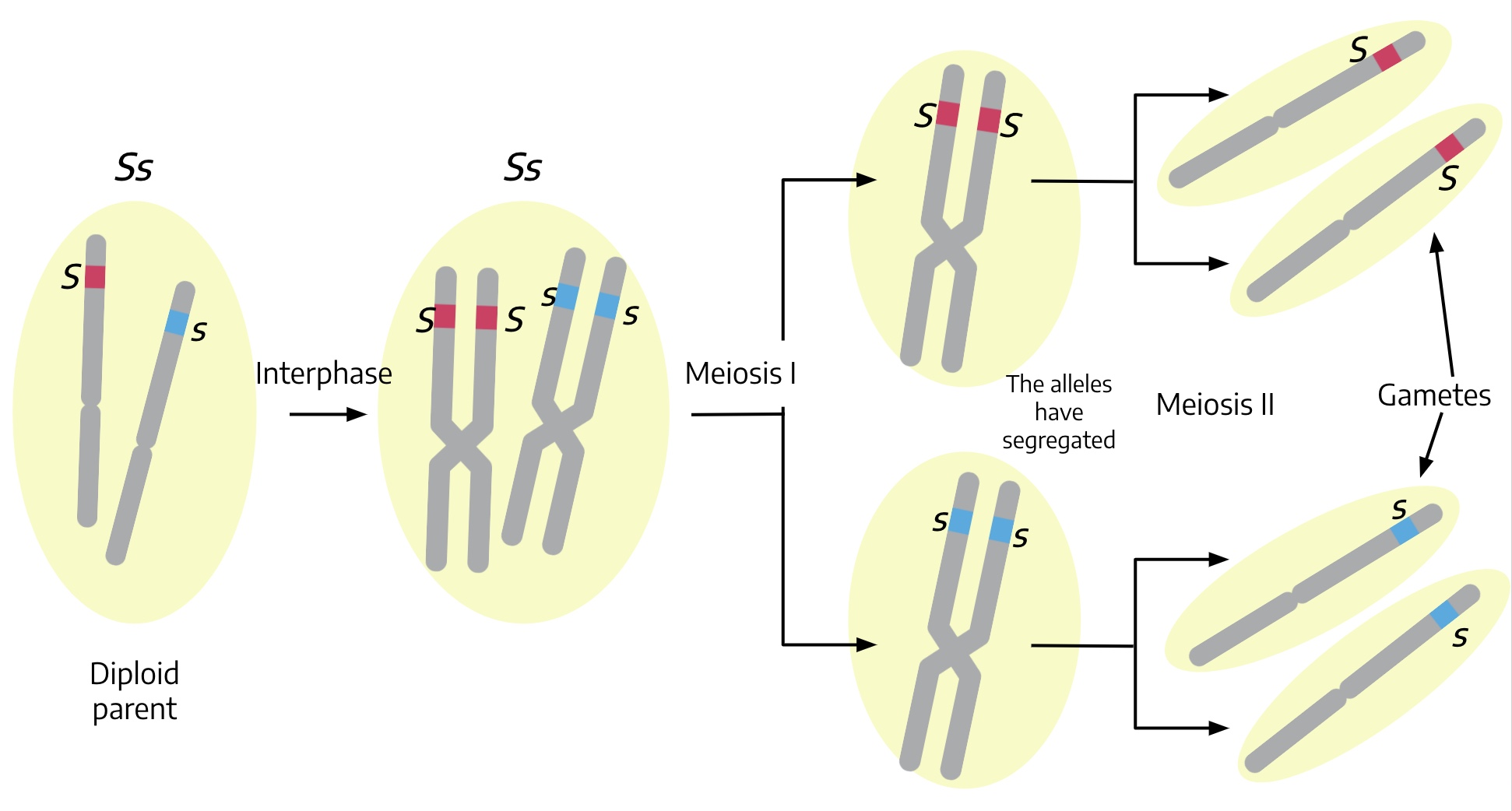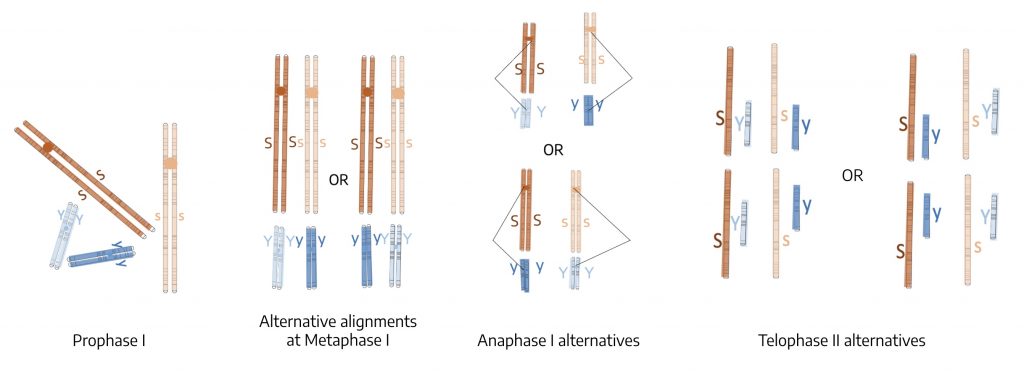14.2: Inheritance of Big Differences
- Page ID
- 93199
By the end of this lesson you will:
- Compare the difference between simple and complex inheritance and explain how that difference is based on the number of genes involved and on the influence of the environment.
- Predict the types of offspring expected when crossing two parents that differ for their alleles at one locus, or when self-pollinating an F1 hybrid.
- Predict the types of offspring expected when crossing two parents that differ for their alleles at two loci.
- Use a Punnett square to calculate the expected frequencies of different types of offspring.
Quantitative or qualitative differences?
This lesson and the next focus on the inheritance of characteristics that are passed down from parents to their offspring (also called progeny). This lesson focuses on the inheritance of large differences among plants that you can easily see or measure and can report in qualitative terms, such as red vs, yellow flowers, tall vs, short plants, or early vs, late maturity. The next addresses the inheritance of comparatively small differences that require more meticulous measurement and are reported in quantitative terms, such as seed yield in kg/ha, or milligrams of sucrose per gram of grape tissue. The expression of characteristics that are qualitatively inherited (larger, discrete differences) is influenced primarily by the plant’s genes. The environment has little effect on the plant for these characteristics. In contrast to qualitative inheritance, plant characteristics that are quantitatively inherited are influenced by the environment, and sometimes the influence of the environment overshadows that of the genes themselves.

Recall that the genetic code lies in the order of the purine (Adenine and Guanine) and pyrimidine (Cytosine and Thymine) bases in the DNA double helix. Some of these base sequences don’t appear to have a function, but others are translated into structural and enzymatic proteins that influence cell and plant growth. The sequences that are translated into proteins that influence cell and plant growth are called genes. In corn, for example, the sucrose manufactured in the leaves through photosynthesis is transported through the phloem to the ear and into the developing seed or kernel. There the sucrose is broken down to simpler sugars like glucose that are linked together into starch for storage in the corn kernel’s endosperm. The starch synthesis process is catalyzed by a series of enzymes that are produced as a result of expression of a set of corn genes. If even one of those genes is defective and doesn’t produce an enzyme used in the sequence of reactions leading to starch, starch production could be halted.
Shrunken-2 (Sh2) corn contains a DNA sequence (gene) mutation that renders nonfunctional an enzyme that is key to normal starch biosynthesis. Starch biosynthesis is interrupted at an early stage of kernel growth, so instead of accumulating starch, the kernel accumulates sucrose in the endosperm. Shrunken-2 (sh2) corn has high kernel sucrose levels and is one of the common types of “supersweet” sweet corn. This is an example of a large difference (a qualitative trait), because you can easily distinguish the difference between a bite of starchy field corn from a bite of sweet corn, and because the difference in sweetness is the result of just one mutant gene. This mutation is not, however, good for the vigor of the plant in the early spring. A seed that has accumulated sucrose rather than starch is very susceptible to fungus infection at planting time in comparison to the starchy seed of field (commonly called dent) corn. Sweet corn is not nearly as vigorous during germination as regular dent corn, as the dent corn has stored high amounts of starch in its endosperm while the sweet corn has not.
The principles of qualitative inheritance are consistent with the concepts of DNA structure, with genes and meiotic divisions resulting in segregation, and independent assortment of chromosomes. These principles of inheritance were actually worked out before knowledge of DNA, genes, and meiosis, using carefully controlled experimentation, crosses between contrasting parents, observation of progeny, and genius in developing and testing hypotheses.
- Let’s say a carrot breeder is showing us one of her carrot experiments. She planted 20 different types of carrots. If we see that some of the varieties have red tap roots, some have white roots, and others have the usual orange roots, do we suspect that the genetic control of red, orange, and white root colors is qualitatively (large, discrete differences) or quantitatively (smaller differences requiring measurement) inherited?
- If, later in the season, we inspect the data on root yield for each of these 20 varieties, and see that all of the varieties have a fairly similar yield in kilograms per hectare (the highest yielding carrot is perhaps 20% higher than that of the lowest yielding carrot), do we suspect that the genetic control of root yield is qualitatively or quantitatively inherited?
Phenotype, genotype, and environment
This simple arithmetic expression highlights a central concept of how genes and environment combine to influence a plant’s appearance:
Phenotype = Genotype + Environment
Phenotype means the characteristics we actually observe about the plant. Is it tall? Short? Green? Yellow? Starchy? Sweet? The starchiness or sweetness of corn from a garden is one example of a phenotype. Phenotype is the actual expression of a characteristic in the plant that can be measured or expressed in some way.
Genotype is the genetic composition of a plant, including chromosomes of the nucleus and the DNA in chloroplasts and mitochondria. The genotype of a plant is subdivided into genes, which are the hereditary units consisting of a sequence of DNA that occupies a specific location on a chromosome (locus) and determines a particular characteristic in an organism. Genes undergo mutation when their DNA sequence changes, which results in changes in a gene, for example a flower color gene that mutates from red to white in color. The alternative versions of the DNA sequences making up the gene are called alleles. Shrunken-2, introduced above, is a gene. That gene is found at a particular location of a chromosome, and that location is called the gene’s locus. At that locus will be one of the gene’s alleles. It will either be the allele for the normal enzyme that facilitates starch formation, or the mutant allele that blocks starch formation and leads to supersweet corn. The sequence of the purine (A, G) and pyrimidine (C, T) bases along the DNA strand and the differences the sequence imparts to the genetic code produce differences among gene alleles.
Environment is the total influence of known and unknown factors, other than genotype, that might affect this trait, like rainfall, soil type and fertility, temperature, insect predation, and other influences that we may not recognize, but might still affect the phenotype.
Phenotype is then the sum of the genotypic and environmental effects. If you are a sociologist, then you might be familiar with arguments about whether a certain type of human behavior is due to “nature” or “nurture.” Roughly, “nature” corresponds to genotype while “nurture” corresponds to environment. A shorthand representation for the equation introduced above is P = G + E, which roughly corresponds to
Behavior = Nature + Nurture
For more on genotype and environment influences on a plant’s phenotype, see this Wikipedia page (optional).
Genotype (G) has a much larger influence on phenotype (P) than does environment (E) when considering simply inherited characteristics that result in large, qualitative differences. Supersweet sweet corn is going to be sweet corn and not starchy field corn regardless of whether it is grown in Minnesota, California, or in a greenhouse on Mars. The exact amount of sucrose may differ a bit depending on environmental stresses, like how hot or cool the growing season is (hot seasons tend to result in slightly more sugar), but the genotype has a much larger impact on the sweet phenotype than the environment. It is quite common for large differences to be inherited through a single gene that has a large impact. This is called simple inheritance, major gene inheritance, or qualitative inheritance.
In contrast, environmental effects typically have a major impact on phenotype when considering inherited characteristics that are expressed as smaller, quantitative differences, such as those you might find when comparing common bean cultivated varieties (cultivars) for their seed yield, or spinach cultivars for the amount of chlorophyll in their leaves. The impact of the environment might even be larger than the effect of genotype. For example, the rank order of bean yield for three kidney bean cultivars grown in Minnesota might be Cultivar A > Cultivar B > Cultivar C, but if you grow them in Pennsylvania, it could be the reverse, due to a change in environment. It is common for small differences to be inherited through many genes each with a very small impact, where the cumulative effect of their acting together is noticeable. This is sometimes called complex inheritance, minor gene inheritance, or quantitative inheritance, because many genes each with small effect are involved.
- Thinking back to the carrot questions above, will environment have a greater impact on root yield or root color?
Inheritance of a qualitative trait
Watch this video for an introduction to qualitative traits (11:29)

Gregor Johann Mendel, who lived from 1822 to 1884, was an Austrian monk and scientist who studied the simple inheritance of large, obvious differences among pea plants and developed the fundamental principles of modern genetics. He demonstrated that the large differences passed from parents to progeny are transmitted between generations through discrete units or packets of information that control the expression of specific characteristics, and that these discrete units are independently inherited. Take a look at this web page (optional) for background on Mendel, or browse here.
As noted above, Mendel chose pea, Pisum sativum L., as his model organism. Pea usually self-pollinates. It is one of those plants where the pollen is shed and the stigma is receptive even before the flower opens (recall that this is called cleistogamy). Egg and sperm come from the same plant and, following fertilization, form the embryo. The flower is conveniently large enough though that if you very carefully open up a flower bud a few days before the pollen sheds, you can remove the anthers and pollinate the stigma with pollen from another plant, making it fairly easy to cross if you emasculate the flower and supply another source of pollen. If left to its own devices, however, the pea flower self-pollinates.
Mendel looked at a number of qualitative traits controlled by single genes, including:
| Gene | Phenotype |
| Seed shape | smooth vs wrinkled |
| Seed color | green vs yellow |
| Flower color | purple vs white |
| Several other obvious pod and plant characteristics that can be seen by eye |

Mendel crossed a parent plant grown from a smooth seed (P1) to another parent (P2) grown from a wrinkled seed. These parents were selected because they were true breeding, meaning that if they allowed to self pollinate they always produced the same type of seed. When P1 was pollinated (crossed) with P2, all of the seeds resulting from the cross (called F1, short for first filial generation) were smooth-seeded.
Here’s a summary of the experiment so far:
P1 (smooth) X P2 (wrinkled) → F1 (all smooth)
Mendel then planted the F1 seeds, let them naturally self-pollinate, and collected the seeds produced by these plants. He counted a total of 7324 F2 (second filial generation) seeds and found that 5474 were smooth and 1850 wrinkled. This is roughly a ratio of 3 smooth : 1 wrinkled. This, and other similar results, led him to the development of a model where seed plumpness is controlled by one gene with two different versions (or alleles) of the genetic code for that gene. Furthermore, based on the results, when one of each allele was present in the F1 progeny, the allele donated from the smooth seeded P1 parent was dominant to the recessive allele donated from the wrinkled-seeded P2 parent. Dominant here means that if two different alleles are present in an organism, but only one is expressed (like the smooth seed being expressed even though alleles for both smooth and wrinkled are present), the allele that is expressed is called the dominant allele, and the allele that is not expressed is called recessive. Recessive alleles are only expressed if no dominant alleles are present.
If we signify the dominant allele for smooth seeds as the upper case S and the recessive allele that codes for a wrinkled shape as lower case s, the three different possible genotypes are:
- SS diploids that are smooth (homozygous dominant).
- Ss diploids that are also smooth. Here, in the heterozygous genotype, you can tell which allele is dominant to the other. Both alleles are present (S and s), but only one is expressed — the S — so S must be dominant to s.
- ss diploids that are wrinkled (homozygous recessive).
Note that, by convention, the designation for the allele ( like S or s) and the genotype (like Ss) is underlined.
Above is a diagram showing the smooth (SS) and wrinkled (ss) parents crossing to form Ss (smooth) F1 progeny. Recall that if an SS parent goes through meiosis, only an S type of gamete is formed. There cannot be any s gametes, because the parent only has the S allele. Likewise, only s gametes are possible when an ss parent undergoes meiosis and forms gametes. So Ss progeny is the only possible result from crossing an SS parent to an ss parent. The phenotype of all of these progeny will be smooth because S is dominant to s. Notice that, in this example, which is one of big, qualitative differences, there is no influence of the environment, so Phenotype = Genotype.

The next step in the experiment is to allow the smooth, Ss F1 progeny to self-pollinate. The lower part of the above diagram shows that the F1 plant will produce two types of gametes, S and s, in equal numbers. Think back to meiosis and gametogenesis. Just before a diploid cell with genotype Ss heads into meiosis, the homologous chromosomes (one carrying the S allele and the other carrying the s allele) replicate in interphase so that there are four sister chromatids, two with the S allele and two with the s allele. The illustration to the left shows how the S and s alleles segregate. The process of meiotic cell division will result in each of these sister chromatids winding up in a separate spore, so of the four male gametes formed during microgametogenesis, two are carrying S and two are carrying s. The one surviving gamete from megagametogenesis has an equal probability of being either S or s (recall that of the four spores, only one survives), so if you consider many egg cells, roughly half will be S and half will be s. Mendel’s results, and his explanation, are thus consistent with what we know about meiosis.
You can use a simple tool called a Punnett Square to visualize the types of zygotes, and their expected frequency, formed from the male and female gametes resulting from self-pollination of an Ss individual, as shown below:

The male gametes, S and s are shown in the two columns across the top of the square, and the female gametes, also S and s, are listed down the left margin. Each cell shows the contribution of one male gamete and one female gamete.
In this example, self-pollinating (also called selfing) an Ss F1 plant means that we list S and s as possible male gametes and also as possible female gametes, since both sperm and egg are from the same F1 plant. The potential zygotes are shown in the four cells inside the square.
If you count up the results of from the Punnett square, you find that the genotypic ratios of the F2 progeny are:
1 SS : 2 Ss : 1 ss
and the phenotypic ratios are:
3 S- (Smooth) : 1 ss (Wrinkled)
which is precisely the ratio that Mendel found between smooth and wrinkled seeds in his F2 pea generation. Recall that the difference between the genotypic and phenotypic ratios occurs because S is dominant to s so you can’t tell the phenotypic difference between SS and Ss genotypes.
Mendel's First Law — the law of segregation — states that during gamete formation each member of the allelic pair separates from the other member to form the genetic constitution of the gamete. That is, in the F1, the Ss diploid produces S and s gametes, not Ss gametes. Mendel’s work paved the way for figuring out this process.
- Using the Punnett square diagram above, explain why the expected frequencies for the three possible genotypes should indeed be 1 SS : 2 Ss : 1 ss.
Simultaneous inheritance of two qualitative traits
Watch this video for an introduction to independent assortment (12:01)
Here is a slightly more complex situation, but one that can still be understood through your knowledge of meiosis. We’ll simultaneously consider seed shape (or plumpness) and another characteristic, seed color, that Mendel studied. Like seed shape, seed color is controlled by one gene with two alleles where:
- YY diploids are yellow
- Yy diploids are also yellow
- yy diploids are green
You can tell from the heterozygote Yy that the Y allele for yellow color is dominant to the recessive y allele for green.
Note that the gene for seed shape is on a different chromosome than the gene for seed color. Mendel didn’t know this, as the concept of chromosomes had not yet been proposed. Because they are on separate chromosomes, seed color and seed shape will assort independently.
Let’s start by crossing a plant that grew from a smooth, yellow seed known to have the genotype SSYY to a plant that grew from a wrinkled green seed with genotype ssyy.
SSYY X ssyy → ?
The only type of gamete that can be produced by the SSYY parent is SY, and the only type that can be produced from the ssyy parent is sy. The F1 progeny can only be the double heterozygote SsYy, which has smooth, yellow seeds.
SSYY X ssyy → SsYy
Next, allow the SsYy F1 progeny to self pollinate. Below is a diagram of key stages of meiosis for a cell with genotype SsYy. Note that the seed shape gene is on one type of chromosome (straight) and the seed color on another (squiggled).

- At Prophase I the chromosomes are replicated and show sister chromatids.
- At Metaphase I we see that the homologs have synapsed and lined up on the metaphase plate. There are two ways that the recessive and dominant alleles can line up on a metaphase plate. The left side of Metaphase I shows that both dominant gene homologs are on the same side; the alternative alignment on the right side shows that the dominant homolog for one gene could just as likely line up with the recessive homolog for the other gene.
- The way they line up at Metaphase I determines how they separate at Anaphase I, so the diagram of Anaphase I shows two alternatives for how the homologs migrate to the poles. This has an impact on the types of spores produced in Telophase II.
- In the Telophase II frame above, the left side shows that. based on one of the Anaphase I alternatives, the result can be for the dominant S and the dominant Y to be together in one type of spore and both recessive genes together in other spores. Equally likely, as shown on the right, the result can b eone dominant gene with one recessive gene.
Meiosis and gamete formation in the SsYy F1 thus results in an equal likelihood of four types of gametes: SY, sY, Sy and sy. If we create another Punnett Square to model self pollination of the SsYy F1 and put these four gametes both across the top and down the margin (since we are allowing the plant to self pollinate, and the frequency and genotype of the gametes will be the same whether egg or sperm), we get the results shown.
Looking at the diagrams of the seeds in each cell, you can count the number of times each of the four possible phenotypes appears. The phenotypic ratios are:
9 S-Y- (smooth yellow) : 3 S-yy (smooth green) : 3 ssY- (wrinkled yellow) : 1 ssyy (wrinkled green)
The dash “-” in the genotype, like S-, means that the allele represented by the “-” could be either the dominant or the recessive allele because, regardless of which allele is there, the phenotype remains the same. So S- means both SS and Ss genotypes.
Don’t memorize these ratios, but understand how they were obtained using the Punnett Square. When Mendel conducted this experiment and counted the seeds of each phenotype he obtained, he found:
315 smooth yellow, 108 smooth green, 101 wrinkled yellow, and 32 wrinkled green
which is pretty close to a 9:3:3:1 ratio.
This result for two genes on different chromosomes led to Mendel's Second Law — the Law of Independent Assortment. During gamete formation, the segregation of the alleles of one allelic pair is independent of the segregation of the alleles of another allelic pair (illustrated above with the alternative alignments at Metaphase I). That is, when gametes form from an SsYy F1, and receive either S or s (as stated in the first law of segregation), whether Y goes with S to make up a SY gamete or whether y goes with S to make up a Sy gamete is completely by chance. Remember the mechanics behind this, from learning how homologs separate through independent assortment in Anaphase I of meiosis.
Mendel’s initial insights on segregation and independent assortment are the foundation of genetics. He uncovered the core principles that were only later confirmed by our understanding of chromosomes, genes, alleles, and cell division. For another optional look at Mendel’s laws, and another take on this material, see Phil McClean’s (a Prof at NDSU) web site on Mendelian Genetics.
- Cover up the Punnett Square above, and without peeking, fill in the cells on your own and derive the genotype and phenotype ratios from selfing the SsYy hybrid.
- What are the differences between the law of segregation and the law of independent assortment?


